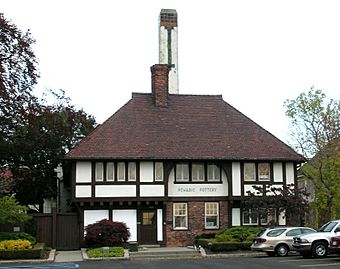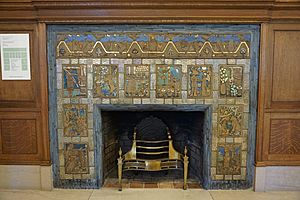Pewabic Pottery facts for kids
|
Pewabic Pottery
|
|
 |
|
| Location | 10125 East Jefferson Avenue Detroit, Michigan |
|---|---|
| Area | less than one acre |
| Built | 1908 |
| Architect | William B. Stratton; Baldwin, Frank D. |
| Architectural style | Tudor Revival, Kentish Inn |
| NRHP reference No. | 71000430 |
Quick facts for kids Significant dates |
|
| Added to NRHP | September 3, 1971 |
| Designated NHL | December 4, 1991 |
Pewabic Pottery is a special place in Detroit, Michigan. It's a studio where beautiful pottery is made, and also a school where people learn about ceramics. It started way back in 1903. The studio is famous for its shiny, colorful glazes. You can see these glazes on tiles in famous buildings like the Shedd Aquarium in Chicago. Pewabic Pottery is still open today. It was named a National Historic Landmark in 1991. This means it's a very important historic place.
Contents
The Start of Pewabic Pottery
Pewabic Pottery was created in 1903. An artist and teacher named Mary Chase Perry Stratton started it. Her business partner was Horace Caulkins. Horace was an expert with high-heat ovens called kilns. He invented a special "Revelation kiln." Mary was the artistic leader and helped sell their work.
Their teamwork brought together art and technology. This made Pewabic Pottery unique. It became Detroit's important part of the worldwide Arts and Crafts movement. This movement focused on making beautiful things by hand.
The name "Pewabic" comes from an Ojibwa word. "Wabic" means metal, and "bewabic" means iron or steel. Mary Stratton's father worked at a copper mine called Pewabic when she was a girl. The pottery is well-known for its special shiny glazes. These glazes cover the pottery and tiles they make.
In 1991, Pewabic Pottery became a National Historic Landmark. It is Michigan's only historic pottery center. It still operates in a building built in 1907. This building looks like a Tudor Revival style home. Today, Pewabic Pottery is a non-profit school. They teach classes in ceramics. They also have exhibitions and sell pottery made there. They also sell art from other artists. Plus, they design and make tiles for buildings.
Exploring the Museum and Galleries
Pewabic Pottery has a museum. Its exhibits show how the company helped shape Detroit's history. They also show its role in the Arts and Crafts movement in America. You can learn about how ceramic art grew in the country. The galleries also display new art by modern ceramic artists.
Amazing Artworks and Tiles
Pewabic Pottery creates many kinds of handmade decorations. Their pieces are in famous art collections. These include the Detroit Institute of Arts and the University of Michigan Museum of Art. The Freer Gallery of Art also has their work.
Under Mary Stratton's guidance, Pewabic Pottery made lamps, pots, and tiles for buildings. Architectural tiles were a big part of Pewabic's history. They were famous for their shiny glazes. These tiles were used in churches, concert halls, and libraries. They also decorated museums, schools, and other public buildings.
Pewabic's work can be seen in many buildings. You can find them across Michigan and the United States. Some famous examples include Herzstein Hall at Rice University in Texas. The Shedd Aquarium in Chicago, Illinois, also features their tiles.
One very special project was at the Basilica of the National Shrine of the Immaculate Conception. This is in Washington, D.C. Pewabic made arches with shiny tiles there. They also made large ceramic circles for the ceiling. Plus, they created fourteen Stations of the Cross for the crypt.
Today, Pewabic's design team still creates beautiful tiles for buildings. You can see their modern work at Comerica Park. This is where the Detroit Tigers baseball team plays. Other places include the Detroit Medical Center Children's Hospital. They also made tiles for five Detroit People Mover stations. You can also find their work at Herald Square in New York City.
Pewabic Tiles in Buildings

Pewabic tiles were, and still are, very popular. Many of Detroit's best buildings have them. You can find them in places like:
- Cathedral Church of St. Paul, Detroit, Michigan
- Detroit Institute of Arts, Detroit, Michigan
- Detroit Public Library Children's Room, Detroit, Michigan
- Guardian Building, Detroit, Michigan
- Hill Auditorium, University of Michigan, Ann Arbor, Michigan
- Michigan Historical Museum, Lansing, Michigan
- Scott Fountain, Belle Isle Park, Detroit, Michigan
See also
- Arts and Crafts movement
- Detroit Yacht Club
- List of National Historic Landmarks in Michigan
- Niloak Pottery
- Pottery
- Rookwood Pottery Company
- Studio pottery
- Tile
- Van Briggle Pottery
- William B. and Mary Chase Stratton House


